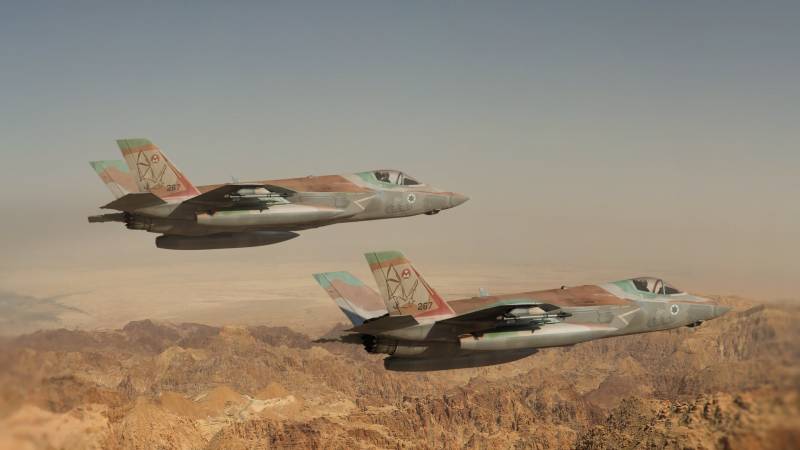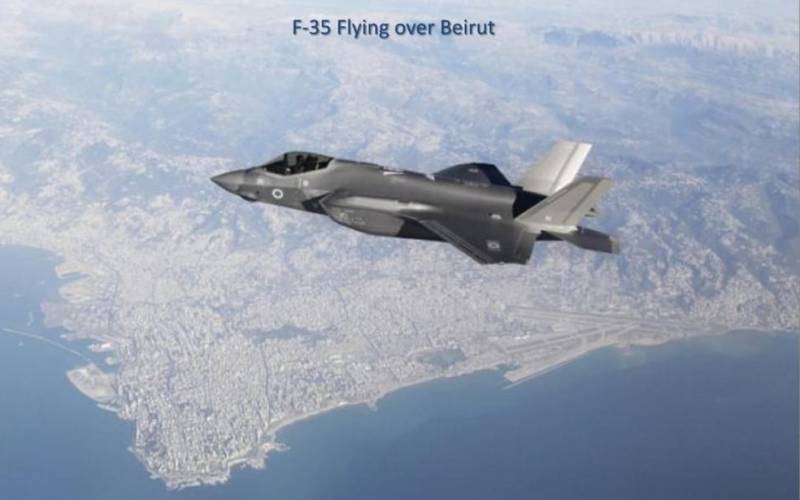The sign puncture of the Israeli Air Force in the sky over Beirut before the war with Iran: no easy ways are expected
TEL AVIV AND WASHINGTON BEGIN THE GAME WITHOUT EUROPE
During the first month since the cancellation of the “nuclear deal” with the Islamic Republic of Iran, announced by Donald Trump 9 in May 2018, during the White House briefing, two extremely important meetings took place between Israeli leader Benjamin Netanyahu and Russian President Vladimir Putin, as well as the heads of defense departments States Avigdorom Lieberman and Sergey Shoigu. As is known, during the talks, the last of which took place with the participation of the Chief of the General Staff of the AOI, Gadi Ayzenkota, the operational situation in the Syrian theater of operations was examined in detail. Also, unofficial agreements were reached, in accordance with which the Israeli army refuses regular attacks on the units of the Syrian Arab army and ceases to support the militants of the Free Syrian Army and Al-Nusra (banned in the Russian Federation) in the south-western “opposition beachhead” around Dar'a, in exchange for this, Tel Aviv received a bonus in the form of stopping the transfer of anti-missile systems C-300PMU-2 “Favorite” to the Syrian air defense forces, as well as Russian pressure on Damascus and Tehran. Ia Iranian units of the Revolutionary Guards in the territories of Quneitra Province, adjacent to the Golan Heights.
In fact, we have mutually beneficial points of contact, thanks to which the contingent of the Russian Aerospace Forces in Syria and the command of the CAA receive noticeably less intensity of fire resistance from the militants during the upcoming sweeping of the Dar'a environs (American support through Jordan’s territory is also present, but without Israel’s support decrease significantly), and the IDF receives dividends, which consist in the elimination of the main fears ’units of the IRGC from the close approaches; Including small detachments of volunteers and Iranian military advisers. But, unfortunately, all these "undercover games" and unofficial deals with Israeli officials do not lead to the main goal - to relieve pre-escalation tensions in the entire Asian region, where the most interested party in fomenting a regional conflict with Iran is precisely the Jewish state that uses its lobby in the US Congress and Senate for the speedy inclination of Washington to the military scenario. It is for this reason that after Lieberman’s April visit to Washington for consultations with the head of the Pentagon, James Mattis, we observed an unusually rapid denunciation of the nuclear agreement.
Nevertheless, having managed with cunning, by concluding the 110 billion-dollar arms contract in May 2017 and providing the opportunity to participate in the division of the Syrian territories on the eastern bank of the Euphrates, to "put together" an anti-Iranian military-political coalition involving Saudi Arabia, Washington and Tel Aviv they tried to ignore the position of European players, for whom the loss of Tehran in the energy market is completely disadvantageous. After all, every day the countries of the European Union get 0,45 million barrels of oil from Iranian fields. But there are also other areas of economic cooperation with Iran, bringing the European "money-box" a multi-billion dollar income. For example, the Airbus contract alone for the supply of Iranian carrier Iran Air of passenger A320, A330 and A350 / WXB airliners is estimated at 18 billion dollars. For this reason, it is quite logical to observe the earliest creation by the European Commission of a special package to protect European companies from sanctions pressure from the US Treasury, which became known to 17 in May. Recall that about three months ago, the current US Treasury Secretary Steven Mnuchin made a statement about blocking the assets of European companies that interact with the Iranian side.
At the moment, the Israeli side in the person of Prime Minister Benjamin Netanyahu, who is completing the tour of the three leading states of Europe (Germany, France and Great Britain), has not found any support for the American-Israeli initiative to get out of the “nuclear deal”. German Chancellor Angela Merkel, French President Emmanuel Macron, as well as British Prime Minister Theresa May pointed out that there is no alternative to the current agreement from the EU point of view. This is exactly what was expected. Puzzled by the failed trip to Europe, Bibi immediately tried to divert the attention of the world press with unexpected aggressive rhetoric towards the Syrian leadership, accusing him of supporting the missile attacks of the Iranian units on the IDF strongholds on the Golan Heights.
He also threatened to strike again at the positions of the CAA, which are located near the division of the IRGC. But everyone knows who was the first to regularly strike at the outskirts of Damascus Airport, and also attacked the warehouses of Yahont anti-ship missiles P-800 belonging to the Syrian Arab Army. And therefore, to complain about countermeasures taken by Iranian military units, Israel has no right. Moreover, following the Russian-Israeli consultations, the activity of the IRGC units in the south of Syria with Moscow’s submission actually decreased, as evidenced by the tactical online map syria.liveuamap.com.
There is only one conclusion: Tel Aviv is trying to obscure the public with fake statements about continuing anti-Israeli actions of the IRGC from the southern provinces of Syria, while Moscow fulfills its obligations, and Europe completely refuses to follow Washington’s destructive activities in Front Asia The main goal of Tel Aviv against this background is to maintain a high level of tension in the region, which is why we see today such statements of Netanyahu being sucked from the finger.
Tehran in this difficult situation behaved quite adequately and predictably: 5 June 2018 of the year, at the beginning of the Israeli Prime Minister’s tour of European countries, the head of the Atomic Energy Organization of Iran, Ali Akbar, informed the IAEA of the beginning of the process of increasing uranium enrichment, as well as launch of new centrifuge production facilities in Natanz. In response, US Secretary of State Mike Pompeo did not find anything more original than to state that Washington "will not allow Tehran to develop nuclear weapon". In reality, the situation is such that the implementation of an official massive missile attack on Iranian nuclear facilities, as well as covering their anti-aircraft missile batteries with Tomahawk strategic cruise missiles and tactical long-range AGM-158B JASSM-ER, promises the Pentagon a huge shaft of problems, consisting in a retaliatory strike on US Air Force bases in the United Arab Emirates and Qatar (Al-Dafra and El-Udeid) by Iranian tactical ballistic missiles "Fateh-313" with a range of 500 km, as well as medium-range ballistic missiles -keeping "Sajjil-2» and «Qadr».
"PROKOL" NEAR LEBANAN AIR SPACE
As a result of such a "retaliatory response", Washington may, within just a few minutes, lose its strategic foothold (jump airfields, etc.) on the western coast of the Persian Gulf. It is easy to assume that even the US Air Force command is unlikely to approve of such a scenario. Another thing is a sudden, lightning-fast and maximally covert operation, similar in level of surprise to Hel Haavir's preemptive strike on the air bases of the Egyptian, Syrian and Jordanian air forces in the Six Day War called Moked (Focus), as well as a similar operation to Osirak in the plan of quickly and invisibly overcoming air defense systems in low-altitude flight mode. It is no secret that the greatest bets in such a daring air mission can be made exclusively on one instrument - the Israeli Air Force, whose flight personnel have already had a high level of experience in deceiving enemy air defense systems for 51 years. The main means in such an operation will be not so much the tactical fighters F-15I "Ra'am" and F-16I "Sufa", which have a huge EPR of 2 and 10-12 square meters. m, respectively, how many advanced stealth fighters of the 5th generation F-35I "Adir", equipped with two external fuel tanks and equipped with inconspicuous "narrow bombs" of the GBU-39 / B "SDB" type, successfully used against targets of the government forces of Syria about a month ago ...
At the moment, the command of Hel Haavir in the person of Major General Amikam Norkin, as well as the flight crew of the 140 Fighter Squadron receiving the Adira, sing in ode to this vehicle, emphasizing its low visibility in the enemy airspace, viewed through radar detectors given by the Buk-М2Е ("Dome") and С-300В / С-400 (9С15М2 "Review-3" and 96Л6). So, about three weeks ago, an F-35I “Adir” photo appeared flying online over the waters of the Eastern Mediterranean, about 15 km from Beirut (the photo shows the airport of the capital of Lebanon). But what else do we see in this photo?
A small trapezoid module can be seen in front of the left tail of the vertical tail unit (stabilizer), which is nothing more than a Luneberg lens, a device designed to increase the effective diffusion surface visible by the enemy’s radar to indicators that are hundreds of times greater than real. But what is the purpose of placing a set of 4-x Luneberg lens on sverhmalozametnom fighter 5-generation flying at a distance of about 140-150 km from Tartus, where the division of S-300V4 dowry radar "Review-3» and C-400 with BBO 96Л6, capable of detecting a target with 0,005 ESR apt. m (as stated by state specialists) from a distance of the entire 30 — 50 km? It is quite easy to answer this question: the real EPR of the advertised “toys” worth 90 million dollars is very far from the figures provided by the Americans and makes up those very 0,1 — 0,2 square meters. m, about which for over a decade Russian experts and bloggers have been talking.
Objects with such a reflective surface are capable of bearing the above-mentioned Russian radar stations at a distance of 140 km. So we were the witnesses of the first serious puncture, which questioned the parameters of the secrecy of Lightnings in general and Adirov in particular. It is quite natural that adding to this “radar portrait” also suspended fuel tanks, which for low-altitude maneuvering in the Iranian mountain ranges of Zagros are sure to be required, will increase the effective reflective surface to even higher elevations; and we all remember well that our “300th” in the PMU-2 version and with the “long-sighted” 64Н6Е detection radars the Iranian side has already received, which means we are making the appropriate conclusions.
Information sources:
https://theaviationist.com/2018/05/24/image-of-israeli-f-35-flying-off-beirut-with-radar-reflectors-as-well-as-more-details-about-the-adirs-first-strikes-emerge/
http://forum.militaryparitet.com/viewtopic.php?id=20819
http://forum.militaryparitet.com/viewtopic.php?id=20699
http://rbase.new-factoria.ru/missile/wobb/c300v/c300v.shtml


Information